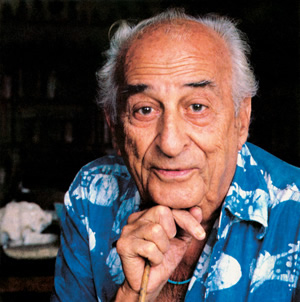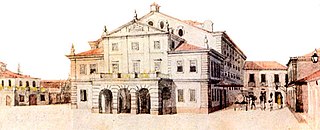
Botafogo is a beachfront neighborhood (bairro) in Rio de Janeiro, Brazil. It is a mostly upper middle class and small commerce community, and is located between the hills of Mundo Novo, Dona Marta and São João. The word Botafogo also refers to a Latin American ballroom dance move that originated in this area.

Yerma is an opera in three acts by Heitor Villa-Lobos based on the tragedy of the same name by Federico García Lorca.

Maurício Waldman is a Brazilian academic and environmental activist.
The Prêmio José Reis de Divulgação Científica is an annual honor awarded by the Brazilian Council of Scientific and Technological Development (CNPq) to the institution, media organization, publication, or individual who most contributed to the dissemination and public awareness of science and technology in Brazil. It is thus named in honor of Dr. José Reis, a Brazilian biologist and science writer who was one of the pioneers in the field.
Brígida Baltar was a Brazilian visual artist. Her work spanned across a wide range of mediums, including video, performance, installation, drawing, and sculpture. She was interested in capturing the ephemeral in her artwork.

Héctor Julio Páride Bernabó was an Argentine-Brazilian artist, researcher, writer, historian and journalist. His nickname and artistic name, Carybé, a type of piranha, comes from his time in the scouts. He died of heart failure after the meeting of a candomblé community's lay board of directors, the Cruz Santa Opô Afonjá Society, of which he was a member.
João Guilherme Ripper is a Brazilian composer and conductor.

The João Caetano Theater is located in Tiradentes Square, in the Brazilian city of Rio de Janeiro. It offers 1,139 seats, including 605 in the audience, 117 in the noble balcony and 417 in the simple balcony. It is the oldest playhouse in the city.
Teatro Miguel Falabella is a theatre in Rio de Janeiro, Brazil. It was inaugurated on 21 August 1997.
Teatro dos Sete is a theatre in Rio de Janeiro, Brazil. Founded in 1959 by Gianni Ratto, it has featured actors such as Fernanda Montenegro, Henriette Morineau, Sérgio Britto, Ítalo Rossi, and Fernando Torres.

Teatro São Pedro(English: São Pedro Theater) is located in São Paulo, Brazil. It was created by the Portuguese Manuel Fernandes Lopes and inaugurated on January 20, 1917 with the performances of the plays A Moreninha and O Escravo de Lúcifer. It is the second oldest operating theater in São Paulo.

A Barraca is a Portuguese theatre company founded 1975 and directed by Hélder Costa and leading actress Maria do Céu Guerra. It is based at the Teatro Cinearte on 2 Largo de Santos, Lisbon.
Dalal Achcar is a Brazilian ballet master, choreographer, artistic director and producer.

The Museu da Imagem e do Som do Rio de Janeiro was inaugurated on September 3, 1965, as part of celebrations of the fourth centenary of the city of Rio de Janeiro. The MIS is a museum of the Secretary of Culture of the state of Rio de Janeiro dedicated to carioca culture.

Chôros No. 10 is a work for chorus and orchestra written in 1926 by the Brazilian composer Heitor Villa-Lobos. It is part of a series of fourteen numbered compositions collectively titled Chôros, ranging from solos for guitar and for piano up to works scored for soloist or chorus with orchestra or multiple orchestras, and in duration up to over an hour. Chôros No. 10 is of moderate length, one performance recorded by the composer lasting just under thirteen minutes.

Mariuccia Iacovino was a Brazilian violinist and instructor. A child prodigy on the violin, she studied in Brazil and Spain and performed internationally. At the end of World War II, she moved to Paris and performed as a soloist with the Cologne Orchestra. In 1964, she and the Quarteto da Guanabara received the first prize from the international Villa-Lobos String Quartet Competition and in 1966, she was awarded the Carlos Gomes Medal in Rio de Janeiro.
Vera Chaves Barcellos is a Brazilian artist and educator. She was featured in the Radical Women show at the Brooklyn Museum in 2018.

The following outline is provided as an overview of and topical guide to Rio de Janeiro:

Confeitaria Colombo is a coffeehouse located in downtown Rio de Janeiro, Brazil. It is one of the main landmarks of the city's Central Region. Website City Guides named Colombo one of the 10 most beautiful cafés in the world.
Sábato Antonio Magaldi was a Brazilian theater critic, playwright, journalist, teacher, essayist and historian.











